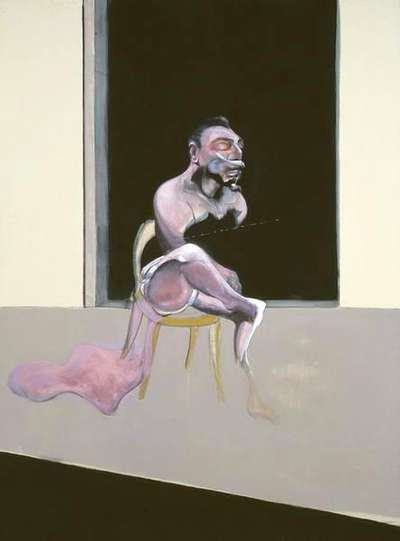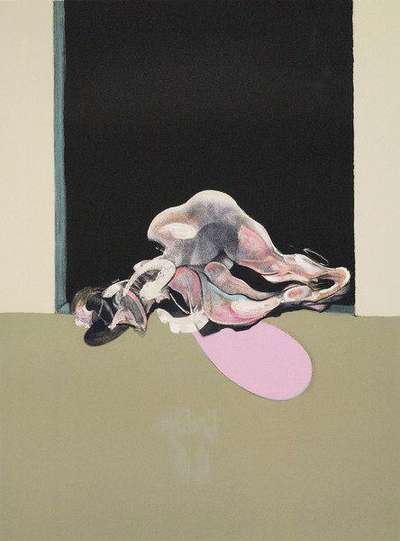
Triptych August 1972 (right panel)

Triptych August 1972 (right panel)
Signed Print
Francis Bacon
£7,000-£10,000Value Indicator
$13,500-$20,000 Value Indicator
$12,500-$18,000 Value Indicator
¥60,000-¥90,000 Value Indicator
€8,500-€12,000 Value Indicator
$70,000-$100,000 Value Indicator
¥1,340,000-¥1,910,000 Value Indicator
$9,000-$12,500 Value Indicator
AAGR (5 years) This estimate blends recent public auction records with our own private sale data and network demand.
There aren't enough data points on this work for a comprehensive result. Please speak to a specialist by making an enquiry.
Medium: Lithograph
Edition size: 180
Year: 1989
Size: H 66cm x W 48cm
Signed: Yes
Format: Signed Print
TradingFloor
Track this artwork in realtime
Watch artwork, manage valuations, track your portfolio and return against your collection
Track auction value trend
Auction Results
| Auction Date | Auction House | Location | Hammer Price | Return to Seller | Buyer Paid |
|---|---|---|---|---|---|
| June 2019 | Forum Auctions London | United Kingdom | |||
| November 2014 | Artcurial | France | |||
| March 2014 | Waddington's | Canada | |||
| May 2011 | Germann Auctions | Switzerland | |||
| November 2009 | Phillips New York | United States |
Meaning & Analysis
Haunting and mournful, Francis Bacon's Triptych August 1972 is one of the artist's most harrowing works from his so-called 'Black Triptychs'. Created after the suicide of his lover and long-term companion, George Dyer, Triptych August 1972 (right panel) is testament to Bacon's consuming grief. Sat on the same chair that Dyer sits on in Triptych August 1972 (left panel), is Bacon's haunted figure rendered in fleshy tones, pink, and blue. In stark contrast to Dyer's ghostly figure, Bacon's appears much more weighted with the musculature of his torso pronounced. With his face positioned as though looking out towards the viewer, this panel provides a definitive end to the triptych, after Triptych August 1972 (centre panel). As in the other two panels of the triptych, a rectangular black void stretches up the composition, appearing to recess into the background like a doorway to death.
Created in the year following the death of George Dyer, Triptych August 1972 is an homage to Bacon's longing and regret for the loss of his lover and companion. Triptych August 1972 (right panel) is a self-portrait in which Bacon confronts his loss and gives the viewer a direct gaze into his face, which is evidently pained with guilt. Bacon met Dyer at the end of 1963 in one of Soho's pubs, and the pair's lives became instantly intertwined. Born into a family of organised crime and debauchery, Dyer was a troubled gang-associated man who, unsurprisingly, piqued the interest of Bacon's psychologically penetrative imagination. Throughout their tumultuous relationship, Bacon painted Dyer numerous times, but Triptych August 1972 (right panel) betrays Bacon's grief after Dyer's untimely death. Just one day before Bacon's solo show at Paris' Grand Palais in October 1971, Dyer's body was discovered slumped over the toilet of his hotel suite.
Though Bacon pronounces the musculature of his solid and lively form, his left shoulder appears cast in shadow, which merges with the tall void in the background. Unlike Dyer's figure in Triptych August 1972 (left panel), which fades into a ghostly nothingness, Bacon's appears spliced by this shadow to signify the loss of an important part of his being. Likewise, Dyer's gaze is pointed across the panels of the triptych towards Bacon, desperately longing for his attention. This gaze, however, is not returned by Bacon. Instead, he painted himself head-on, contorting his face to reveal the torture of his loss. To the right of his figure, a fleshy shadow pools onto the floor, which is mimicked in Triptych August 1972 (left panel), like a ghost of the relationship that bound the two together in life. Much like its companion panels, Triptych August 1972 (right panel) is thus one of Bacon's most psychologically poignant and immersive works, relaying the artist's loss, grief, and guilt during this cataclysmic year of his life.

